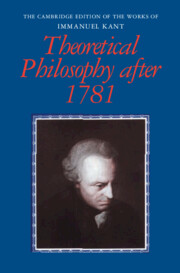Book contents
- Frontmatter
- Contents
- General editors' preface
- General introduction
- Prolegomena to any future metaphysics that will be able to come forward as science (1783)
- Metaphysical foundations of natural science (1786)
- On a discovery whereby any new critique of pure reason is to be made superfluous by an older one (1790)
- What real progress has metaphysics made in Germany since the time of Leibniz and Wolff? (1793/1804)
- On a recently prominent tone of superiority in philosophy (1796)
- Settlement of a mathematical dispute founded on misunderstanding (1796)
- Proclamation of the imminent conclusion of a treaty of perpetual peace in philosophy (1796)
- Editorial notes
- Glossary
- Index of names
- Index of subjects
Settlement of a mathematical dispute founded on misunderstanding (1796)
Published online by Cambridge University Press: 29 July 2009
- Frontmatter
- Contents
- General editors' preface
- General introduction
- Prolegomena to any future metaphysics that will be able to come forward as science (1783)
- Metaphysical foundations of natural science (1786)
- On a discovery whereby any new critique of pure reason is to be made superfluous by an older one (1790)
- What real progress has metaphysics made in Germany since the time of Leibniz and Wolff? (1793/1804)
- On a recently prominent tone of superiority in philosophy (1796)
- Settlement of a mathematical dispute founded on misunderstanding (1796)
- Proclamation of the imminent conclusion of a treaty of perpetual peace in philosophy (1796)
- Editorial notes
- Glossary
- Index of names
- Index of subjects
Summary
In an essay in the Berliner Monatsschrift (May 1796, pp. 395–96), among other examples of the fanaticism that may be induced by attempts to philosophize about mathematical objects, I also attributed to the Pythagorean number-mystic the question: “Why is it that the ratio of the three sides of a right-angled triangle can only be that of the numbers 3, 4, and 5?” I had thus taken this proposition to be true; but Professor Reimarus refutes it, and shows (Berliner Monatsschrift, August, no. 6) that many numbers, other than those mentioned, can stand in the ratio in question.
So nothing seems clearer than that we find ourselves embroiled in a truly mathematical dispute (of a kind that is, in general, almost unheard of). But this quarrel amounts only to a misunderstanding. Each party takes the expression in a different sense; so soon as a mutual understanding is reached, the dispute vanishes, and both sides are correct. Now proposition and counter-proposition are related as follows:
R. says (or at least thinks his proposition thus): “In the infinite multitude of all possible numbers (considered at large) there exist, in regard to the sides of the right-angled triangle, more ratios than that of the numbers 3, 4, and 5.”
- Type
- Chapter
- Information
- Theoretical Philosophy after 1781 , pp. 447 - 450Publisher: Cambridge University PressPrint publication year: 2002

